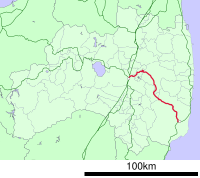Ban'etsu East Line
You can help expand this article with text translated from the corresponding article in Japanese. Click [show] for important translation instructions.
|
| Ban'etsu East Line | |||
|---|---|---|---|
 A KiHa 110 series DMU near Kanmata Station, September 2018 | |||
| Overview | |||
| Native name | 磐越東線 | ||
| Status | In operation | ||
| Owner | JR East | ||
| Locale | Fukushima Prefecture | ||
| Termini | |||
| Stations | 16 | ||
| Service | |||
| Type | Heavy rail | ||
| Operator(s) | JR East | ||
| Depot(s) | Kōriyama | ||
| Rolling stock | KiHa 110 series DMU | ||
| History | |||
| Opened | 1915 | ||
| Technical | |||
| Line length | 85.6 km (53.2 mi) | ||
| Number of tracks | Entire line single tracked | ||
| Character | Rural | ||
| Track gauge | 1,067 mm (3 ft 6 in) | ||
| Electrification | None | ||
| Operating speed | 100 km/h (62 mph) | ||
| |||
The Ban'etsu East Line (磐越東線, Ban'etsu-tō-sen) is a railway line in Fukushima Prefecture, Japan operated by East Japan Railway Company (JR East). It connects Iwaki Station in Iwaki and Kōriyama Station in Kōriyama. The name "Ban'etsu" is taken from the first characters of the names of the ancient provinces of Iwaki (磐城) and Echigo (越後), which the Ban'etsu East and Ban'etsu West lines connect. "Tō" (東) means "east" in Japanese.
The line's nickname is the Yūyū Abukuma Line (ゆうゆうあぶくまライン), taken from the Abukuma River that flows nearby.
Service
[edit]All trains are operated as local services in 2-, 3-, or 5-car formations. Service between Kōriyama and Ononiimachi is provided once every 30 minutes to two hours, but between Ononiimachi and Iwaki, there is a period of five hours where no trains operate. One reason for the few continuous services between Iwaki and Kōriyama is the opening of the parallel Ban-etsu Expressway in 1995; as a result, most long distance passengers use highway bus services.
The last express service, Iwaki, stopped running in 1982. During peak holiday periods such as Golden Week, Obon, and New Year, the rapid Abukuma makes a single round trip with a 2-car train.
Station list
[edit]- All stations are located in Fukushima Prefecture.
- Trains can pass one another at stations marked "◇", "∨", or "∧". Trains cannot pass at stations marked "|".
| Station | Japanese | Distance (km) | Rapid Abukuma |
Transfers | Location | ||
|---|---|---|---|---|---|---|---|
| Between stations |
Total | ||||||
| Iwaki | いわき | - | 0.0 | ● | Jōban Line | ∨ | Iwaki |
| Akai | 赤井 | 4.8 | 4.8 | | | | | ||
| Ogawagō | 小川郷 | 5.5 | 10.3 | ● | ◇ | ||
| Eda | 江田 | 8.0 | 18.3 | | | | | ||
| Kawamae | 川前 | 8.0 | 26.3 | | | ◇ | ||
| Natsui | 夏井 | 10.4 | 36.7 | | | | | Ono, Tamura District | |
| Ononiimachi | 小野新町 | 3.4 | 40.1 | ● | ◇ | ||
| Kanmata | 神俣 | 6.5 | 46.6 | ● | ◇ | Tamura | |
| Sugaya | 菅谷 | 3.3 | 49.9 | | | | | ||
| Ōgoe | 大越 | 4.4 | 54.3 | ● | ◇ | ||
| Iwaki-Tokiwa | 磐城常葉 | 4.4 | 58.7 | | | ◇ | ||
| Funehiki | 船引 | 3.8 | 62.5 | ● | ◇ | ||
| Kanameta | 要田 | 7.0 | 69.5 | | | ◇ | ||
| Miharu | 三春 | 4.2 | 73.7 | ● | ◇ | Miharu, Tamura District | |
| Mōgi | 舞木 | 6.1 | 79.8 | | | ◇ | Kōriyama | |
| Kōriyama | 郡山 | 5.8 | 85.6 | ● | Tōhoku Shinkansen, Yamagata Shinkansen, Tōhoku Main Line, Ban'etsu West Line, Suigun Line[* 1] | ∧ | |
- ^ Although the official start of the Suigun Line is Asakanagamori, all trains run through to/from Kōriyama.
Rolling stock
[edit]As of February 2009, the following rolling stock is used on the East Ban'etsu Line.
- KiHa 110 series DMUs
History
[edit]The line was planned by the Railway Construction Act in 1892. The Japanese Government Railways opened the first section as the Heigun West Line (平郡西線) between Koriyama and Miharu in 1914. The Iwaki - Ogawagō opened in 1915 as the Heigun East Line (平郡東線), the same year Miharu - Ononiimachi section opened. When the two sections were connected in 1917, the line became the Ban'etsu East Line.
Freight services ceased in 1987.
References
[edit]External links
[edit]![]() Media related to Ban'etsu East Line at Wikimedia Commons
Media related to Ban'etsu East Line at Wikimedia Commons
- Stations of the Ban'etsu East Line (JR East) (in Japanese)

